
| |
 HIGH SCHOOL HOLOGRAM PORTRAIT PROGRAM HIGH SCHOOL HOLOGRAM PORTRAIT PROGRAM
Hey . . . you just KNOW that these two guys are up to no good, right? That's Bill Pugh of Englewood High School in Jacksonville, FL on the left; and mischief-maker sidekick, me, Frank DeFreitas on the right. We're in my holography lab in Allentown, PA, stirring up more trouble. Actually, we're just happy for successful shots after having started the day at 7:00 a.m. -- just as a late-winter snow storm was beginning to hit the area. Remember, Bill doesn't see any snow in Florida. The look on his face when we took our first break was priceless! He took a picture of his truck with snow covering it, and hasn't seen or felt snow since he was a kid. Me? I'm sick of the stuff. Enough already! So Bill, here's a picture as of 8:30 p.m. tonight looking out back toward the water garden. Those white reflective dots that you see in the flash is now freezing rain and sleet . . . which is coating the snow (and, unfortunately, the roads) with a hard cover of ice. Real nice, huh?
I've been working with Bill helping him get his laser & holography program together for his students at the high school, where he teaches Communication Technologies. Actually, Bill does quite well on his own, and I kick in whenever any trouble-shooting is needed. Today, Bill stopped by the lab while on spring break, bringing with him masters that were shot for his new hologram portrait program for students. I mentioned to Bill that I believe that this could be the first program ever that allowed students to create hologram portraits at the high school level -- and at an actual high school -- albeit the very simple ones described herewithin. If so, congratulations to Bill, his students, and his program. I've been providing a separate area of this hologram portrait web site for his students when working in the lab. They're also following the web site in general. On other occasions I've visited the high school in Jacksonville to provide hands-on instruction, in general, for creating holograms. Bill has a great lab, all hand-built by himself and his students. Now on to the holograms:
We worked with two portraits today and I'll use "Marge" as our example. Marge was with the Urban Systemic Initiative in Jacksonville when I've been down there, which was a program funded by the National Science Foundation. She is currently with the District Science Department of Duval County, and has been a great support, along with "Holly", of Bill's laser and holography program. It was great to finally get both of them into a hologram portrait -- especially one created within the program itself that they have supported! Along with Bill, Marge and Holly were instrumental in bringing me down to Jacksonville twice now -- and have treated me like a king each time -- including beach-front accommodations with the most beautiful sunrises over the ocean right from my balcony. So thank you to both of you (and Bill, too). As to the hologram, this is an excellent example of what can be achieved when the many elements come together. I've been following their progress from the beginning -- which began as 35mm photography based, reversal processing trannies (Kodak T-Max reversal kit). Bill came up today to get my advice on some final fine tuning -- and now that those suggestions will be put into place, I believe that his students will be off to creating some great hologram portraits. The mastering was done at the high school lab, and we did the transfers here this morning in Allentown. With this one, and as with Holly, the registration of the image throughout all slits was simply astounding. When viewed as a laser transmission hologram, the master was rock-solid -- as if it were only one image. There was not one single slit that had the image the slightest bit out of registration. Not even by a "hair". My jaw just dropped and hit the table. It is just an incredible example of the precision that can be achieved when doing these by hand. Let's take a look at the master:
As you'll notice, the red arrows point to areas where the slits did not line up perfectly. Once again, I remind the reader to review my comments on why the registration of the image itself is of utmost importance . . . above the importance of aligned slits (one is not the same as the other). You can have perfectly aligned slits and an unregistered image, or unaligned slits with a perfectly registered image. Of course, one should always strive for aligned slits AND a registered image. But if one HAS to be off, the aligned slits would be less problematic overall. Unaligned registration usually means do it again. With my method of using the holographic master as a holographic optical element, i.e. the ability to "direct" the image out on an angle for copying -- and having the slits recorded 45-degrees off parallel (unique to my mini-portrait method) -- the effect of mis-aligned slits is minimized (to a degree of course). Not that you can be sloppy! But a "slip of the slit" is not the end of the world IF you have maintained excellent registration throughout the slit recording process. The final hologram is a perfect example of this. See my other sections on the explanation of why I designed this technique to record the slits at an angle to the master plate, rather than parallel as with other stereogram recording geometries. Another area to point out is with the yellow arrows. You'll see that the first and last slit is larger than the remaining middle slits. I designed this into Bill's system to drop the number of slits down to six from eight -- yet, at the same time, covering the same surface area as an eight slit master. This was a time-consideration for classroom work. And, finally, here is the raw reflection transfer hologram:
Fine-tuning suggested areas of improvement with this round are: 1. Strive for a higher contrast ratio with the T-Max reversal processing of the 35mm film -- easily achieved by adjusting f-stop, increasing chem temp by a few degrees, and adding 30 seconds to the development time. This would not only provide a better hologram overall, but also its own additional element to the dimensional quality itself. 2. It's a little "hot" in the center of the image, so the divergence of the object beam during mastering needs to be increased -- not so that it enlarges the image per se, but so that the laser light intensity is more uniform across the diameter of the image on the ground-glass. There is no collimation with this technique. The image is sharper in person than it is in the video frame-grab photos. So very nice job on the focusing as well (both with photography and with ground-glass projection). Overall, quite an achievement for a high school holography lab. And, remember folks, this was done entirely by hand, with hand-made equipment and components. I wish Bill, his students and his program continued success. As for me, I'm getting ready to head upstairs and hearth-bake a loaf of my Tuscan Basil bread -- to enjoy with the fresh marmalade that Bill brought from Florida for Deb and me (along with hand-picked oranges and grapefruit). Thank you Bill.
ENGLEWOOD UPDATE: Very encouraging results from the Englewood High School holography lab! They have completed their own portraits from start to finish, and the results of these first tests are shown below:
If you're visiting for the first time, go here: |
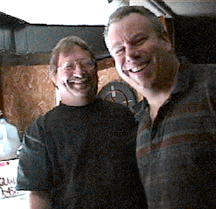

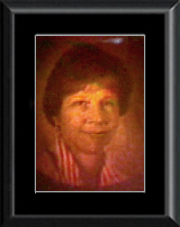
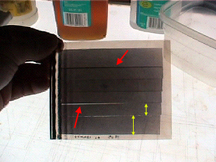
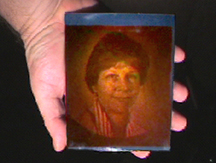 Now, I ask you: Do you see any slits or slit lines in this hologram? No. That's because with this method, the slit lines are not in front of your eyes when looking at the hologram. This is perhaps the most difficult aspect to convey -- as it goes against the "traditional" method of stereogram recording (master plate/slits and image projection parallel and facing head-on). The ability of holography to do this is probably the most puzzling aspect for many people. All I did was take this ability and applied it to this mini-portrait technique, so that they would be more successful when created by hand in an amateur/hobbyist/student environment. I think, overall, it will also be beneficial even when working within the digital realm utilizing an LCD panel for mastering (more on that progress to come).
Now, I ask you: Do you see any slits or slit lines in this hologram? No. That's because with this method, the slit lines are not in front of your eyes when looking at the hologram. This is perhaps the most difficult aspect to convey -- as it goes against the "traditional" method of stereogram recording (master plate/slits and image projection parallel and facing head-on). The ability of holography to do this is probably the most puzzling aspect for many people. All I did was take this ability and applied it to this mini-portrait technique, so that they would be more successful when created by hand in an amateur/hobbyist/student environment. I think, overall, it will also be beneficial even when working within the digital realm utilizing an LCD panel for mastering (more on that progress to come).
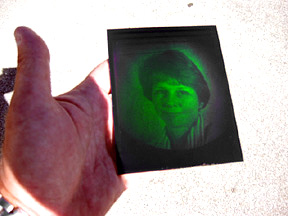
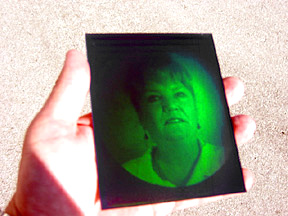 Congratulations to Bill Pugh and his holography program students with these latest results. They are following the ongoing computer workstation/LCD digital imaging process closely, which will allow them to add I.T. skills to their holography program for Communications Technologies.
Congratulations to Bill Pugh and his holography program students with these latest results. They are following the ongoing computer workstation/LCD digital imaging process closely, which will allow them to add I.T. skills to their holography program for Communications Technologies.